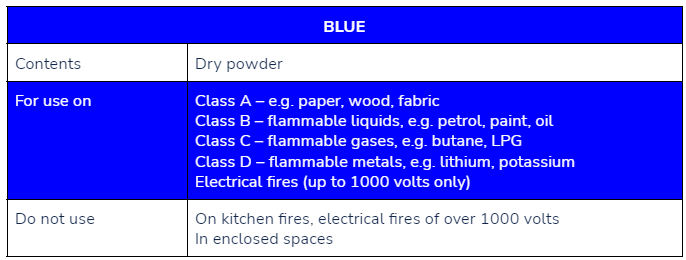A guide to the colours and uses of fire extinguishers
Fire extinguishers are a vital tool when it comes to protecting your staff, your premises, and your assets against the risk of fire. You may know which fire extinguishers need to be used on which type of fire, but in an emergency would you be able to identify the right one by the colour of its label alone, without having to spend time reading it?
Many businesses have a wide range of fire hazards and consequently may have different extinguishers to hand. Being able to immediately lay your hands on the right one could save valuable time and increase the chances of fighting a fire successfully.In this blog, we take a closer look at the colours and uses of fire extinguishers to help you in the event of having to make a fast decision under pressure.
In this blog, we take a closer look at the colours and uses of fire extinguishers to help you in the event of having to make a fast decision under pressure.
What are the colours of fire extinguishers and uses?
Red – Water Extinguishers

Red fire extinguishers contain water and are used for Class A fires, which involve ordinary combustibles like wood, paper, and cloth. These water extinguishers work by cooling the flames and reducing the fire’s temperature to extinguish it effectively. It’s important that these types of fire extinguishers are not used on any electrical fires, kitchen fires, flammable liquids, or gas fires. Red fire extinguishers are one of the most common types of extinguishers and are often found in office buildings, schools, and hospitals for example.
Cream – Foam Extinguishers

Foam fire extinguishers, identified by their cream colour, are a versatile type of extinguisher suitable for use on Class A and Class B fires, which involve flammable liquids like petrol. The foam works by smothering the fire and cooling the fuel surfaces, helping to prevent re-ignition. Again, these extinguishers shouldn’t be used on electrical fires, kitchen fires, flammable liquids or gas fires. These extinguishers are commonly found in settings where both solid and liquid fires are a potential risk, such as offices, warehouses, and garages.
Blue – Dry Powder Extinguishers

Blue fire extinguishers are filled with dry powder and are suitable for use on a variety of fires, including Class A, Class B, Class C (those involving flammable gases such as butane or LPG), and Class D fires (those involving flammable metals like lithium and potassium). They should not be used on kitchen fires, electrical fires, or in enclosed spaces. These versatile extinguishers are often founds in businesses such as garages and workshops where different types of fires may occur.
Black – Carbon Dioxide (CO2) Extinguishers

CO2 fire extinguishers are black in colour, making them easily distinguishable in case of an emergency. These extinguishers are suitable for use on Class B and electrical fires, as they work by displacing oxygen and suffocating the flames. It’s important to note that they shouldn’t be used on kitchen fires, flammable gases, or in enclosed spaces. The non-conductive nature of carbon dioxide also makes these extinguishers safe to use on electrical fires without the risk of causing damage to sensitive equipment. CO2 extinguishers are often found in offices, building sites, and electrical storage rooms such as server rooms for example.
Yellow – Wet Chemical Extinguishers

Yellow fire extinguishers are associated with wet chemical extinguishers, which are specifically designed to tackle Class F fires, involving cooking oils and fats, making them a common type for commercial kitchens, restaurants, canteens. Wet chemical fire extinguishers work by creating a barrier between the burning oil and the oxygen it needs to fuel the fire, effectively smothering the flames. These types of fire extinguishers should not be used on fires involving flammable liquids or gases or electrical fires.
The importance of maintaining your fire extinguishers
Maintaining your fire extinguishers is crucial to ensure they are ready for use in case of an emergency. Regular inspection and maintenance help to guarantee that the extinguishers are functioning correctly and have not expired.
It’s recommended to check the pressure gauge, inspect for any physical damage or corrosion, and ensure that the pin and tamper seal are intact regularly. Ensuring the extinguisher is easily accessible so that everyone in the vicinity knows its location is also important, especially in the event of an emergency. Staying proactive with maintenance gives you peace of mind knowing that your fire extinguishers are in optimal condition to combat any potential fires effectively.
Learn more about the colours of fire extinguishers and types
We hope our guide to the colours and uses of fire extinguishers have given you a better understanding of the different types of fire extinguishers available. It’s important to note that anyone expected to use a fire extinguisher should have the appropriate training to do so to ensure everyone’s safety.
At Hoyles Fire & Safety, we provide, install, and maintain all kinds of fire extinguishers to businesses and organisations in and around Leeds, Huddersfield and Bradford. Great care is taken to ensure that all our fire extinguishers’ labels clearly represent their correct usage. We can also help place your extinguishers in the ideal location for the specific fire risks at your premises.
If you’d like to learn more about the colours and uses of fire extinguishers, or if you have any questions about our services, get in touch with our friendly experts today.
Fire extinguisher FAQs
How do I use a fire extinguisher?
Using a fire extinguisher requires specific training to ensure everyone’s safety in the event of a fire. If you have the adequate knowledge, use the PASS method is the most memorable way of using an extinguisher:
- Pull the pin to break the tamper seal.
- Aim the nozzle at the base of the fire.
- Squeeze the handle to release the extinguishing agent.
- Sweep the nozzle from side to side until the fire is out.
How often should fire extinguishers be inspected?
Below are the recommendations when it comes to inspecting and maintaining your fire extinguisher:
- Monthly: a visual inspection should be done to ensure the extinguisher is fully charged and accessible.
- Annually: a thorough and professional inspection conducted by a certified technician.
- Every 6-12 years: depending on the type of extinguisher, it may need a hydrostatic test or replacement.
Where should I store my fire extinguisher?
You should store your fire extinguisher in an accessible, visible location where fires are most likely to occur (e.g., kitchens, garages, near exits). It should be mounted at a height that allows easy access and you should inform all relevant individuals so they are aware of the location of the extinguisher.
Do fire extinguishers expire?
Yes, fire extinguishers do have expiration dates. They lose effectiveness over time and should be checked for signs of pressure loss, corrosion, or any damage. Look for a date on the label or body of the extinguisher, and replace it as needed.


